Choosing the Best Heat Gun – Buying Guide
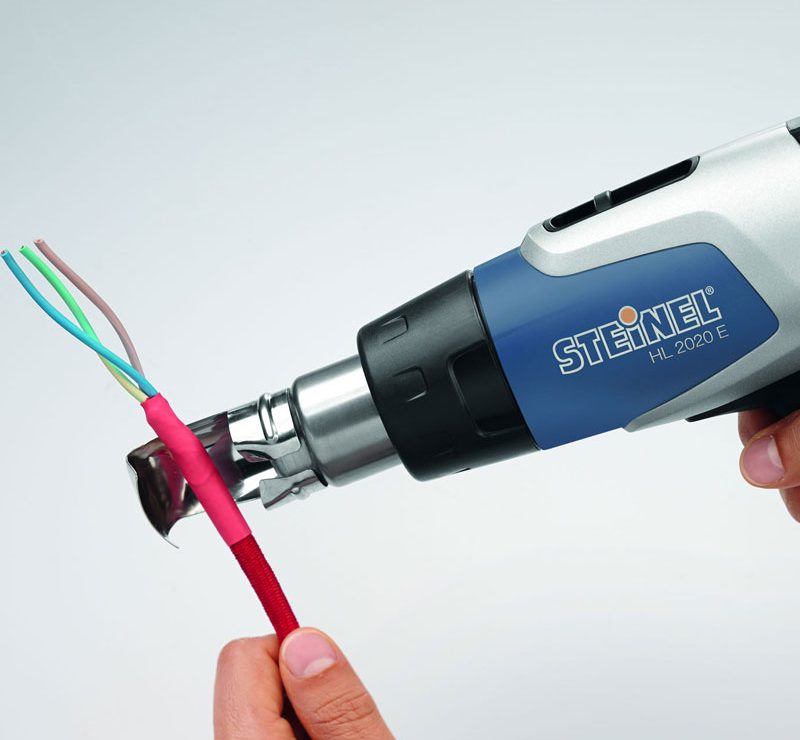
Buyer’s Guide to Heat Guns
In its most basic incarnation, a heat gun consists of a heating element, motor and fan. The fan draws hot air from the heating element and directs it through the nozzle of the tool. Because of their relatively simple construction, heat guns are amongst some of the most affordable power tools available, and due to the wide range of applications they can be used for they make a useful addition to any tool kit. Stripping paint, shrink wrapping, car wrapping, heat shrinking cable sleeves, removing labels & adhesives, thawing frozen pipes, loosening nuts & bolts, welding plastic and tarpaulin, drying out timber, waxing surfboards… there are a long list of jobs that can benefit from a heat gun or hot air tool. But if you’re thinking about buying a new heat gun, how do you work out which is the best machine for your requirements? We’ve compiled this heat gun buying guide to identify some of the features and characteristics to look out for.
1. DIY or Professional
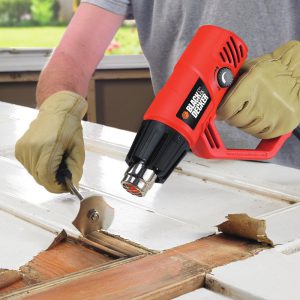
Like most power tools, heat guns are generally designed either for DIY or professional use. DIY in this context means someone who will only require light use from the tool, eg a homeowner stripping paint off their windowsills or an electronics hobbyist heat shrinking cable sleeves in their spare time. A professional user on the other hand would be classed as someone who uses the tool every day, for example in a packing warehouse or a garage. DIY brands include Ryobi, Black & Decker and Bosch Green, and these represent the most affordable hot air tools on the market. However, you should note if you do need the tool for work these models will not usually be covered under warranty if used in this way. Professional grade tools are designed to withstand the conditions of working environments and these include models from brands like DeWalt, Makita and Bosch Blue. One of the most respected names in hot air technology is the German brand Steinel and they manufacture tools for both markets; their DIY range can be identified by a blue colour scheme while their professional tools are grey.
2. Power.
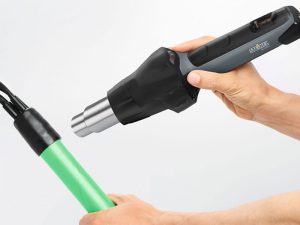
The vast majority of heat guns on the market today are corded electric models, and they have fairly high power requirements – DIY models usually start out around 1800 watts while at the other end of the market the Steinel HG 5000 E Professional Hot Air Tool is rated at 3400 watts and equipped with a factory sealed brushless motor which delivers a maximum airflow rate of 800 litres per minute. As might be expected, higher wattage generally relates to higher overall performance, presuming the tool also includes controls for adjusting the settings. As well as multiple 240v options designed for plugging straight into the mains, some hot air tools are available in 110v, making them safe for use on construction sites and other industrial environments (in conjunction with a step down transformer).
If a power cord is not practical for your requirements, you can also find cordless hot air tools powered by lithium ion battery (like the Steinel BHG 360 36v Cordless Hot Air Heat Gun) or by gas (like the Sealey AK2935 Butane Hot Air Gun).
3. Adjustable Temperature.
To enable them to tackle different tasks, heat guns are typically designed with some sort of temperature adjustment control. On basic models this may be two or three fixed settings, while more advanced tools will have infinitely variable controls that enable precise temperatures to be dialled in. It is common for DIY models to have a fixed 500°C stage as this is the optimum temperature for stripping paint (one of the most common DIY applications for heat guns) along with at least one other lower setting for tasks that require a less intense application of heat.
4. Adjustable Airflow.
An adjustable airflow control lets you dial back the force of the blast from the nozzle, eg when you are working with lightweight materials, or when working near sensitive surfaces that you don’t want to be affected by the heat. Likewise you can also increase it for more air speed, and therefore quicker results. Like temperature control, this can consist of a number of fixed speed settings, or a continuously adjustable dial for more comprehensive control.
5. LCD & LED Displays.
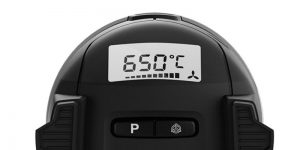
Professional users working to precise tolerances will appreciate the benefits of an LCD or LED display, which can provide visual data on temperature and airflow speed settings – factors that can ordinarily be hard to gauge on machines with continuously variable settings. This enables consistent results and the ability to work confidently with more sensitive materials or applications that call for precise heating conditions. A feature more commonly found on professional machines, LCD screens are also available on high end DIY tools like the Steinel HL 2020 E Heat Gun.
6. Temperature Scanners.
Another feature that is more commonly found on professional machines, but also available for some DIY tools, is a temperature scanner. This is an accessory that may be supplied with the heat gun or purchased as an upgrade to be fitted to it. While many hot air tools provide a facility to gauge the heat being produced by the tool, a temperature scanner instead reads the temperature at the point where the hot air is contacting the workpiece; this provides a more precise way of controlling the application of heat to especially sensitive materials and a more accurate way of identifying surface conditions in temperature critical applications.
7. Thermal Cut-out.
A tool with a thermal cut-out system will automatically shut down if its internal temperature breaches a predetermined threshold (eg after being used for an extended period of time). As well as ensuring user safety, this helps to prolong the lifetime of the tool: Heat is one of the greatest detriments to electronic components and as a result heat guns can lead hard and short lives compared with other power tools. Thermal cut outs are one of the most common built in protection systems to limit the damaging effects of the extreme temperatures that they have to endure in day to day use.
8. Residual Heat Indicators.
The nozzle of a heat gun can remain hot for a long time after use and unsuspecting operators can easily injure themselves by going to pick up a recently used tool, unaware of the residual heat in the exposed metal components. A residual heat indicator helps to safeguard against these accidents by displaying a warning light or similar visual indicator until the tool has cooled down sufficiently to be handled without risk of injury.
9. Flat Backed Housings and Integrated Stands.
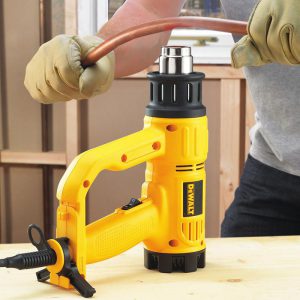
For certain applications, eg bending pipes, it is much more convenient to have the heat gun stationary on a workbench and hold the material over it. For this reason, most heat guns are designed to be used freestanding as well as handheld. If you think you will need to use your hot air tool in this way, look for a model that has a flat backed motor housing and/or integrated stand which will enable you to securely stand it up on a flat work surface for hands free use.
10. Fine dust Filter.
Professional machines like the Steinel HG 2220 E Professional Hot Air Heat Tool have integrated fine dust filters; this will be of particular benefit if you regularly work in construction sites and similar environments, where your hot air tool will be subjected to all kinds of fine dust and debris from drilling, sawing, grinding and sanding operations. This will be sucked into the machine through the fan, and over time it will build up inside the housing, potentially clogging up and damaging the internal components. To stop the majority of these particles entering the tool, a fine dust filter is a simple and effective solution which is designed to help to prolong the performance, efficiency and service life of the machine.
11. Nozzles & Accessories.
Lastly, the machine itself is not always the only consideration when purchasing a heat gun. If you will be using it for a specific application it is worth checking what nozzles or accessories are available to help you with the tasks you need to undertake. Steinel in particular offer a wide range of nozzles and accessories which can be purchased separately, greatly increasingly the versatility and precision with which their tools can be used. When you buy a new heat gun, most will be supplied with at least one or two nozzles to enable you to complete some of the most common tasks out of the box.
Conclusion
If you’re in the market for a new heat gun why not check out the selection of models on our website; if you’d like some more specific advice on the best machine for your requirements feel free to give us a call or drop in to our Brimsdown trade counter to discuss the current available options in more detail.
Categories discussed in this article:

Wow – the Steinel HG 5000 E Professional Hot Air Tool has a factory sealed 3400 watt brushless motor (4.5 hp !). As the heater power is on top of this I guess this is a 3 phase machine.
The Proxxon Hot Air gun is very good for smaller jobs and comes with a number of Nozzles. The only downside is that it does not have a cold position which is useful for cooling jobs and also cooling the heat gun after use so it can be put away safely.
haha good point! Steinel claim the motor itself is rated at 3400W (http://bit.ly/2oCyqvN) but think something may have been lost in translation there… Have amended on our site.
Prices in DOLLERS?
Hi John,
not 100% sure what you mean, but as we’re in the UK I don’t have much info on heat gun pricing elsewhere (and unfortunately we can’t ship outside of the UK) – I’m sure you would be able to find a local distributor if you’re looking for a heat gun?
nice post
Whatis the average lifespan of heat gun ?
Hi Irving, this really depends on how hard you’re working it but for example Steinel Professional heat guns are designed for everyday users and most of these are fully guaranteed for 6 months (in comparison most professional grade power tools such as drills and sanders will come with a three year warranty as standard) – however, if you only need it intermittently a heat gun will last much longer of course. At my old company we occasionally used a Steinel heat gun for shrinkwrapping and it had been in service for at least 10 years